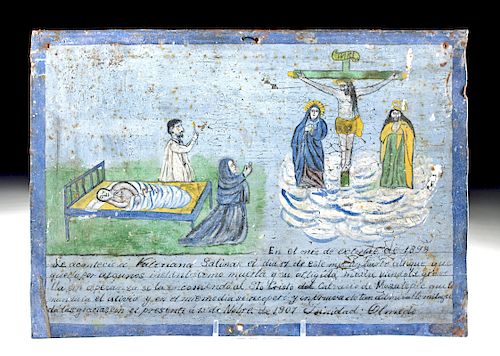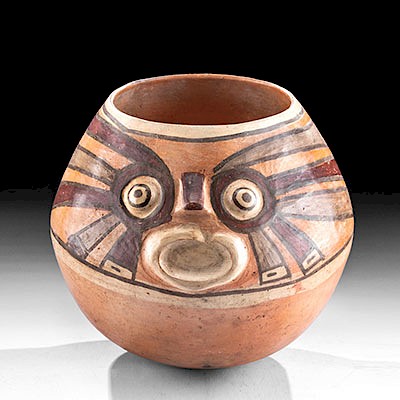Antique Mexican Ex Voto w/ Jesus, Mary, and Joseph
Lot 158
About Seller
Artemis Fine Arts
686 S Taylor Ave, Ste 106
Louisville, CO 80027
United States
Selling antiquities, ancient and ethnographic art online since 1993, Artemis Gallery specializes in Classical Antiquities (Egyptian, Greek, Roman, Near Eastern), Asian, Pre-Columbian, African / Tribal / Oceanographic art. Our extensive inventory includes pottery, stone, metal, wood, glass and textil...Read more
Categories
Estimate:
$600 - $800
Absentee vs Live bid
Two ways to bid:
- Leave a max absentee bid and the platform will bid on your behalf up to your maximum bid during the live auction.
- Bid live during the auction and your bids will be submitted real-time to the auctioneer.
Bid Increments
| Price | Bid Increment |
|---|---|
| $0 | $25 |
| $300 | $50 |
| $1,000 | $100 |
| $2,000 | $250 |
| $5,000 | $500 |
| $10,000 | $1,000 |
| $20,000 | $2,500 |
| $50,000 | $5,000 |
| $100,000 | $10,000 |
| $200,000 | $20,000 |
About Auction
By Artemis Fine Arts
Dec 5, 2019
Set Reminder
2019-12-05 10:00:00
2019-12-05 10:00:00
America/New_York
Bidsquare
Bidsquare : Ancient / Ethnographic - Holiday Edition
https://www.bidsquare.com/auctions/artemis-gallery/ancient-ethnographic---holiday-edition-4710
What to give this holiday season? Ancient & Ethnographic Art of course! Our special Holiday auction features hundreds of unique finds from all over the world. Artemis Fine Arts info@artemisgallery.com
What to give this holiday season? Ancient & Ethnographic Art of course! Our special Holiday auction features hundreds of unique finds from all over the world. Artemis Fine Arts info@artemisgallery.com
- Lot Description
Latin America, Mexico, ca. 1901. A beautiful antique ex voto painted on heavy gauge tin and depicting a woman by the name of Valeriana Salinas who is ill in bed, accompanied by her parents who kneel in prayer to Crucified Christ flanked by Mary and Joseph - the Holy Family aloft on a celestial cloud. Below is an inscription that generally translates, "During the month of October of 1898 / on the 17th of this month, Valeriana Salinas suffered a strong attack that seemed to be the death of her for some time, and her mother without any hope and preparing for the worst resolved to pray to Jesus Christ of Calvario de Mazatepec. Miraculously, she recuperated. For this we give thanks on this 15th of November in 1901. / Trinidad Olmedo." Size: 13.125" W x 9.25" H (33.3 cm x 23.5 cm)
Ex-votos are narrative paintings indicative of healing or blessing. This tradition was inspired by the Greeks and was brought to the New World by the Spaniards. These votive paintings were hung in a church or placed adjacent to an image in order to celebrate and give thanks for the recovery of the donor from an illness or dangerous situation. In essence, ex-votos represent the spiritual or physical gains received by the donor. These paintings include hand painted passages that relate the details of the cure or the rescue. Typically, however, this commentary is replete with regional dialect and somewhat tricky to translate. Nevertheless, if one is familiar with the Spanish language, it is possible to understand the narratives told by these anecdotal paintings.
Provenance: ex House of Ancestors Gallery, Santa Fe, New Mexico; ex private Galisteo, New Mexico, USA collection
All items legal to buy/sell under U.S. Statute covering cultural patrimony Code 2600, CHAPTER 14, and are guaranteed to be as described or your money back.
A Certificate of Authenticity will accompany all winning bids.
We ship worldwide and handle all shipping in-house for your convenience.
#148925Expected age wear with indentations, creases, and surface wear as shown. However, the inscription and imagery are still discernible. Painting has developed nice craquelure. Old perforations at peripheries for former suspension/attachment.Condition
- Shipping Info
-
All shipping is handled in-house for your convenience. Your invoice from Artemis Gallery will include shipping calculation instructions. If in doubt, please inquire BEFORE bidding for estimated shipping costs for individual items.
-
- Buyer's Premium



 EUR
EUR CAD
CAD AUD
AUD GBP
GBP MXN
MXN HKD
HKD CNY
CNY MYR
MYR SEK
SEK SGD
SGD CHF
CHF THB
THB














